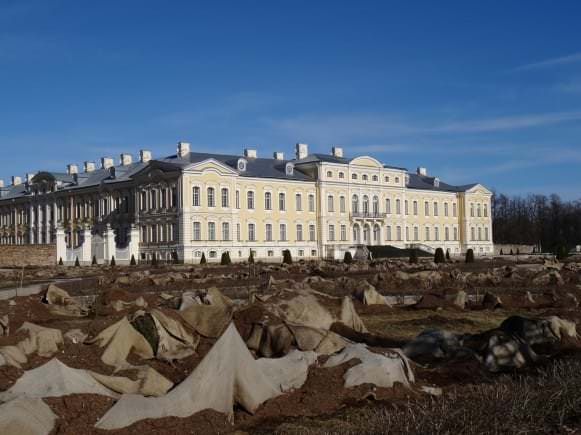The rose garden of Rundāle palace is located on both sides of the ornamental parterre, filling up the areas designed by architect Francesco Rastrelli. Roses were not planted there during the 18th century.

The largest part of the rose garden is taken up by modern roses, which have been grouped by colours, in order for it to be possible to compare the work of various breeders in the formation of a single colour variation. The area closest to the parterre is planted with English roses that resemble old garden roses. There are 52 rose circles dedicated to separate breeders or countries – in them varieties created by 72 breeders from 17 countries can be viewed. Collections of historical roses have been created in the six furthermost beds of the garden. There are rose hedges formed along the eastern and western walls of the garden.

The Rose garden project was started in 2005 and was financially supported by “Latvijas Mobilais Telefons”. The garden was created with a significant help from the Latvian Army and many volunteers.
In total, there are 2230 rose varieties including 600 historical varieties grown in the garden of Rundāle Palace. Although most of the historical varieties only bloom once from late May until mid July, the modern varieties, on the other hand, can flower repeatedly until the first frost. The rose gardens displaying the diversity of species through their forms and hybrids are also very interesting in autumn when visitors are captivated by a variety of colours and forms of rose hips.

HISTORICAL ROSES

The oldest roses grow on the western side of the garden, next to the gardener’s house. The first bed includes roses that were grown during the time of the Dukes Biron until 1795, whereas the second bed includes roses that correspond with the time of the next owners of the palace – the Zubov brothers – until 1822. In the eastern part of the garden, within the three outer historical rose beds, there are roses, which were popular during the time when the palace was owned by Counts Shuvalov (1824 – 1920). More…

The two lines of rugosa roses are considered a separate collection of historical roses, where 72 species of these hardy flowers are growing, having been bred from the final quarter of the 19th century until nowadays.
MODERN ROSES

English roses
White, pink and red English roses grow in the front area on both sides of the parterre, and they resemble the historical roses the most. More…

Gardens of roses grouped according to their colour
The largest part of the rose garden is taken up by modern roses, which have been grouped by colours, in order for it to be possible to compare the work of various breeders in the formation of a single colour variation. More…

Roses bred by Latvian rose breeders
A separate area is dedicated to 18 species of park roses, which have been created by the Latvian breeder Dzidra Rieksta from the rosa rugosa. More…

Roses grouped according to their country of origin
There are 52 rose circles dedicated to separate breeders or countries – in them varieties created by 72 breeders from 17 countries can be viewed. More…
The Blue Rose Garden
The Blue Rose Garden and semicircle next to the gardener’s house portrays the legend of the blue rose grown by the gardener of Rundāle Palace. An interesting collection of “blue” roses can be seen there.

The garden of wild roses, rambling and climbing roses
During recent years, climbing roses have been blossoming lavishly, including multiflorous species, as well as memorial roses (Rosa wichuraiana). There is also an interesting collection of burnet roses, consisting not only of the white roses that are common in Latvia, but also of pink and bright red ones, which have been bred in England out of Rosa pimpinellifolia. Unusually bright orange flowers can be seen on the early blossoming Rosa foetida bicolor. Its yellow variation has provided the selection of roses with a yellow tone. More…
03.06.2020

